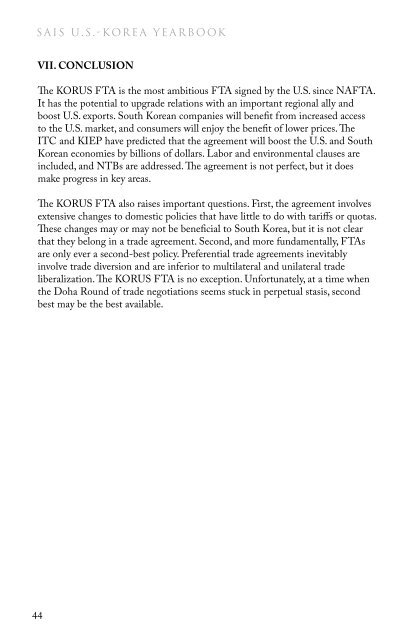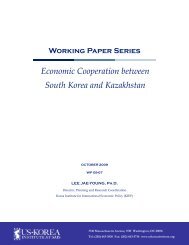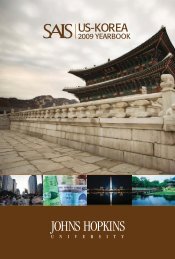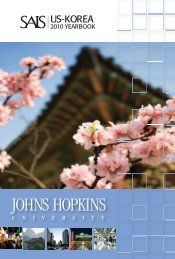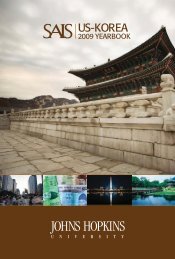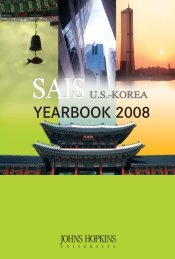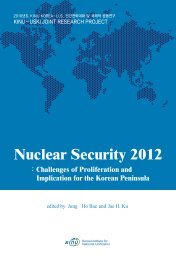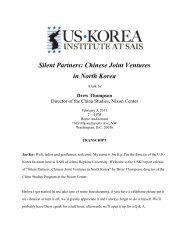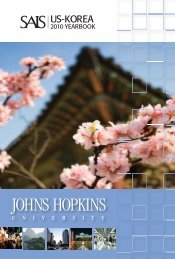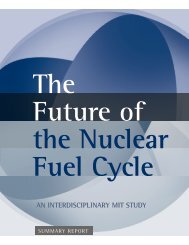YeArBooK 2007 - US-Korea Institute at SAIS
YeArBooK 2007 - US-Korea Institute at SAIS
YeArBooK 2007 - US-Korea Institute at SAIS
Create successful ePaper yourself
Turn your PDF publications into a flip-book with our unique Google optimized e-Paper software.
saIs U.s.-<strong>Korea</strong> YearbooK<br />
44<br />
VII. ConCl<strong>US</strong>Ion<br />
The KOR<strong>US</strong> FTA is the most ambitious FTA signed by the U.S. since NAFTA.<br />
It has the potential to upgrade rel<strong>at</strong>ions with an important regional ally and<br />
boost U.S. exports. South <strong>Korea</strong>n companies will benefit from increased access<br />
to the U.S. market, and consumers will enjoy the benefit of lower prices. The<br />
ITC and KIEP have predicted th<strong>at</strong> the agreement will boost the U.S. and South<br />
<strong>Korea</strong>n economies by billions of dollars. Labor and environmental clauses are<br />
included, and NTBs are addressed. The agreement is not perfect, but it does<br />
make progress in key areas.<br />
The KOR<strong>US</strong> FTA also raises important questions. First, the agreement involves<br />
extensive changes to domestic policies th<strong>at</strong> have little to do with tariffs or quotas.<br />
These changes may or may not be beneficial to South <strong>Korea</strong>, but it is not clear<br />
th<strong>at</strong> they belong in a trade agreement. Second, and more fundamentally, FTAs<br />
are only ever a second-best policy. Preferential trade agreements inevitably<br />
involve trade diversion and are inferior to multil<strong>at</strong>eral and unil<strong>at</strong>eral trade<br />
liberaliz<strong>at</strong>ion. The KOR<strong>US</strong> FTA is no exception. Unfortun<strong>at</strong>ely, <strong>at</strong> a time when<br />
the Doha Round of trade negoti<strong>at</strong>ions seems stuck in perpetual stasis, second<br />
best may be the best available.<br />
T H e “ T e e T H of d I P lo M a C Y ” : U . s . - d Pr K r e l aT Ion s<br />
and THe sIX-ParTY TalKs<br />
THe “TeeTH of dIPloMACY”:<br />
U.S.-dPrK relATIonS And THe<br />
SIX-PArTY TAlKS<br />
rian Jensen<br />
I. InTrodUCTIon<br />
U.S. rel<strong>at</strong>ions with the Democr<strong>at</strong>ic People’s Republic of <strong>Korea</strong> (North <strong>Korea</strong>,<br />
or DPRK) improved dram<strong>at</strong>ically in <strong>2007</strong>, although year-end events raised the<br />
specter of a renewed stalem<strong>at</strong>e. The U.S. ended a four-year mor<strong>at</strong>orium on direct<br />
negoti<strong>at</strong>ions with North <strong>Korea</strong> and achieved important breakthroughs in the<br />
Six-Party Talks, developing a more pragm<strong>at</strong>ic and engaged approach toward<br />
Pyongyang th<strong>at</strong> Secretary of St<strong>at</strong>e Condoleezza Rice has called the “teeth of<br />
diplomacy.” Wider diplom<strong>at</strong>ic l<strong>at</strong>itude (in spite of North <strong>Korea</strong>’s partial nuclear<br />
breakout in October 2006) enabled the top U.S. negoti<strong>at</strong>or, Assistant Secretary<br />
of St<strong>at</strong>e for East Asian and Pacific affairs Christopher Hill, to meet with his<br />
North <strong>Korea</strong>n counterpart, Vice Foreign Minister Kim Kye-gwan, to engage in<br />
serious discussions on North <strong>Korea</strong>’s denucleariz<strong>at</strong>ion and the normaliz<strong>at</strong>ion of<br />
U.S.-DPRK rel<strong>at</strong>ions. In a series of joint agreements in February and October<br />
<strong>2007</strong>—each preceded by productive bil<strong>at</strong>eral discussions—North <strong>Korea</strong><br />
committed to shuttering and disabling its nuclear facilities in return for the<br />
initi<strong>at</strong>ion of U.S. efforts to normalize rel<strong>at</strong>ions and for U.S. and intern<strong>at</strong>ional<br />
provision of economic, energy and humanitarian aid.<br />
Important policy success during <strong>2007</strong> was achieved despite major developments<br />
th<strong>at</strong> punctu<strong>at</strong>ed the negoti<strong>at</strong>ing process, galvanizing outside critics and raising<br />
important concerns about prospects for continued progress. Most seriously,<br />
North <strong>Korea</strong> failed to submit its nuclear declar<strong>at</strong>ion on time and will continue<br />
to work on disabling its Yongbyon facilities—although <strong>at</strong> a slower pace—beyond<br />
the December 31, <strong>2007</strong> deadline. U.S.-North <strong>Korea</strong> rel<strong>at</strong>ions also must<br />
overcome the legacy of a protracted dispute over frozen North <strong>Korea</strong>n funds<br />
45


